Functional clothing: Refit your outfit - repair and care for oilskins correctly
Michael Rinck
· 24.03.2023
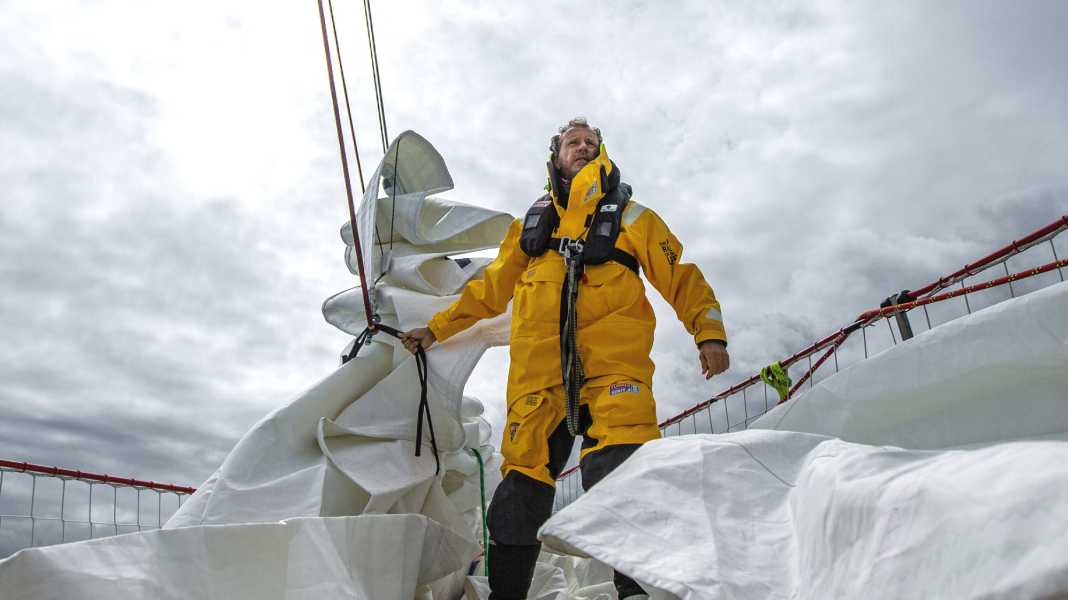
In this article:
An ice-cold trickle of water down the back of your neck is unpleasant; it gets really annoying when you realise that the water hasn't run down your collar, but that your oilskins are leaking. The bad weather clothing no longer fulfils its purpose, and if the zip closes a little awkwardly, the question arises: do you really need a new jacket?
Waterproof clothing is expensive, which is why you should first find out whether the damage can be repaired. This is because most damage to oilskins can be easily repaired.
Owner Raisa Mackarinus and her team have the expertise and are certified by Gore-Tex to carry out repairs on garments with breathable membranes. Frisch GmbH, the German importer of Musto and Zhik, also relies on the tailoring workshop in Kiel for repairs. We visited Raisa Mackarinus in her shop to find out about the most common types of damage, how much a repair costs and the degree of damage that makes an oilskin irreparable.
Professionals such as Outdoor Textile Repair in Kiel have specialised and are certified
The most common types of damage are broken zips, open seams in the neck, leaking seams, chafing or holes, torn appliqués, broken cuffs and hoods. There is also work that is not caused by damage, such as requests for alterations, for example if the trouser legs are too long and need to be shortened.
Zips usually fail because metal parts corrode and the zip becomes increasingly stiff until it is completely broken. Replacement is a routine operation and costs from 80 euros, depending on whether the part needs to be waterproof (if the zip is under a storm flap, this is not absolutely necessary). That's a lot of money - the expensive replacement zip fasteners are the main price driver here.
The repair of multilayer material with membrane requires special expertise that conventional tailoring shops do not have
Damage in the shoulder/neck area is particularly common, as the material is subjected to high levels of stress due to movement and perspiration. The acid contained in sweat in particular can loosen adhesions at seams and lead to delamination of the multi-layer material. In some cases, new fabric must then be used in the affected area.
Leaky seams are another common cause of damage. As every pinprick is a gateway for water, all seams are glued from the inside to make them watertight. The special adhesive strips can peel off. Re-applying the tape requires not only the right material, but also a special machine that heats the tape during application and thus activates the adhesive. The price of the repair depends on the length of the leaky seam. It starts at a moderate 18 euros. It is more expensive for chafed areas or holes. Frequent wear often causes the material to give way at some point on the trouser legs between the thighs and at the crotch. By then, a larger area is usually affected and the material has to be cut out and replaced. Raisa Mackarinus shows us parts that have been elaborately repaired in this way: The replaced areas blend almost invisibly into the functional clothing. And most importantly, the garment is then completely waterproof again.
Individual damage to oilskins can usually be repaired quite cheaply
This is tested using special equipment. The machine seals a round surface with a diameter of around ten centimetres, then water is pressed against the material at up to one bar. In addition to checking the work carried out, the device is also suitable for localising small holes. The removal of a larger scuff mark costs from 60 euros.
Applications such as the Velcro fastening and the belt strap for adjusting the trousers in the hip area or the drawstring on the hood can also give way. Replacing them is usually easy and costs from 18 euros. Replacing an arm cuff is more expensive, with one side costing from 60 euros. Some manufacturers coat the cuffs with latex, which moulds to the wrist and seals well. However, this coating can become porous after a few years. Then the only solution is to replace it completely. The seamstress recommends switching to a neoprene cuff as a replacement. This will last longer. A damaged hood can also be repaired. In most cases, replacing the entire headgear is the best solution.
Even more expensive repairs to the oil are usually worthwhile
For example, if there are two cuffs and a leaky seam with partial replacement of the material in the neck and the zip is already quite stiff. In this case, the work quickly adds up to well over 200 euros. A lot of money for an old jacket. But Raisa Mackarinus says: "Oilskins can provide good service for over 20 years. Provided it is cared for properly." One advantage is that the waterproof clothing is not used every day and only during the season. Damage is therefore often not the result of heavy wear and tear, but rather incorrect care.
But even if the repairs cost more than 200 euros, the expense is usually worth it financially compared to the new price of the jacket. In many cases, this is over 500 euros. And after the repair, the garment can keep you dry and warm for many years to come. So in purely financial terms, a repair makes sense.
If the repair costs turn out to be much higher, you should certainly consider whether the investment is worthwhile or whether a new jacket is not the better choice. It may cost more, but it will also be new.
Oilskin repair is more sustainable than buying new
But there is another aspect besides the financial one that is worth considering when thinking about repairing or throwing away: the environment. As a sailor, you spend a lot of time in nature, use a regenerative CO2-neutral energy source as propulsion (wind) and endeavour to be sustainable. So why not also think sustainably when it comes to clothing? A lot of energy is required in the production of functional clothing, and waste is produced during disposal that cannot always be easily recycled. So if an oilskin jacket or trousers are worn for a long time and can then be used for a few more years thanks to repairs, this directly benefits the environment. Repairing is sustainable. And it's amazing what can still be salvaged.
Most damage can be repaired. In most cases, it is more a question of whether the effort and the associated price are still worth it. It becomes particularly tricky when material has to be replaced in places. In areas where several seams meet, i.e. at the shoulder or in the crotch, great skill is required at the sewing machine to ensure that the result is tight and looks good. The work takes time and costs more. However, almost anything can be repaired. The only restriction: if the membrane has disintegrated over a large area, it is too late. The heart of the oilskin regulates the climate in the clothing. The membrane allows water vapour to pass through, i.e. transports the moist air away from the inside, but at the same time does not allow water droplets from the outside to enter. This means that oilskins do not get wet, even if you sweat a lot during intense activity. If this central component of the garment is defective, even the specialised company can no longer do anything.
An overview of the most frequent damage:
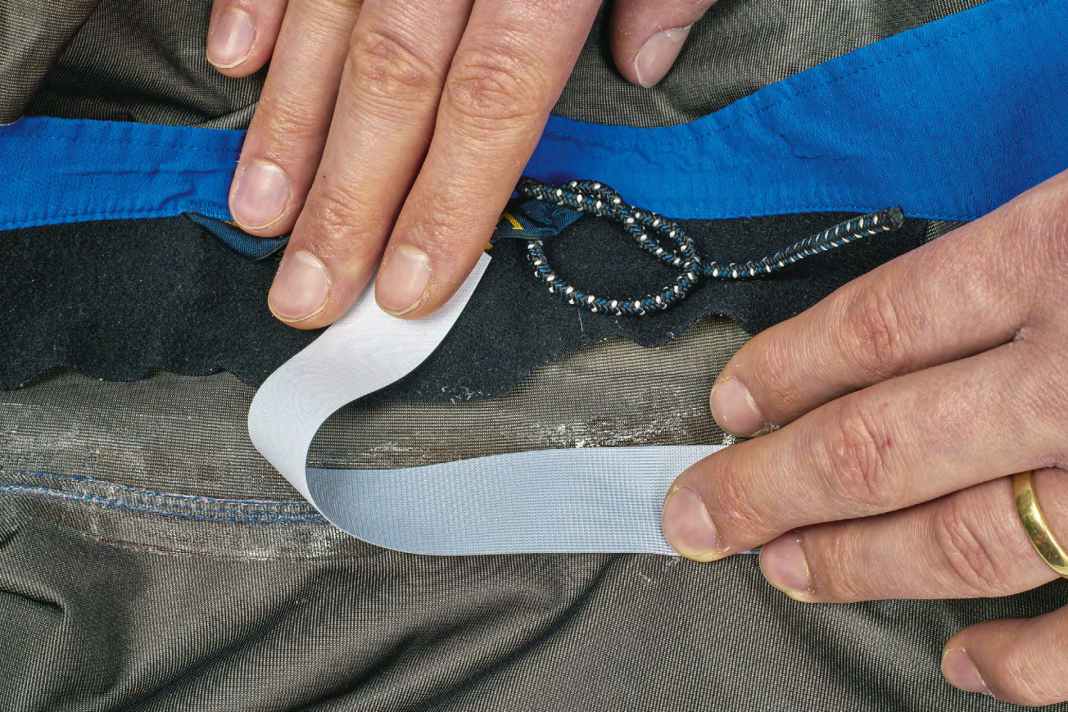





Correct care of sailing clothing is crucial
However, good care is crucial to ensure that expensive clothing lasts a long time. First and foremost: wash regularly. According to Raisa Mackarinus, this is best done every time the clothes come into contact with salt water. Rinsing with fresh water at the jetty is a first step, but it is not enough. The salt damages the membrane. Just like sweat and sun cream on the collar, it must be removed in the washing machine. Follow the manufacturer's recommendations (not too hot!) and use a special detergent for outdoor clothing with a membrane.
Drying comes second. Clothes must not be stored damp in the wardrobe. Mould would also attack the material. However, the expert strongly advises against drying in a tumble dryer at home. The process would be far too hot and the adhesive and membrane would be damaged.
With the right care, oilskins can last 20 years
It is better to hang them up to dry in a well-ventilated place. The Kiel-based specialist company Outdoor Textile Repair also offers cleaning as a service. The oilskins are then dried in an air-conditioned cabinet.
Afterwards, impregnation can be useful so that the fibres of the outer fabric over the membrane do not absorb so much moisture. Cleaning and waterproofing costs 20 euros per jacket, 16 euros per pair of trousers and 29 euros for a suit. However, if the washing instructions are followed, there is nothing to stop functional clothing from being cleaned in the washing machine at home at low cost and without the hassle of shipping.
An overview of the right care:
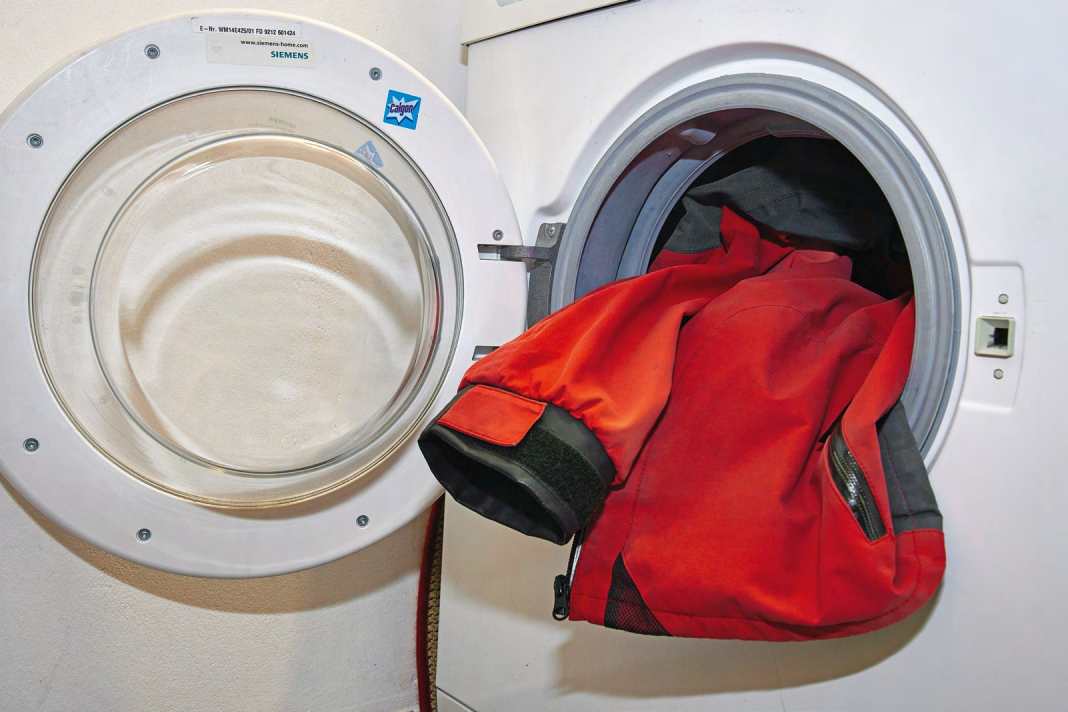





Gore-Tex certification is coveted
In addition to repair and care, Raisa Mackarinus and her team also offer classic alterations, such as shortening trousers and widening the waistband. In this way, an item that does not fit perfectly can be adapted to your own body. There are many alteration tailors, but the big challenge with oilskins is that they not only have to look good, but also be functional. Processing the multi-layered material requires special skills. "I first have to teach even experienced tailors how to do it," says Mackarinus. In order to be certified by Gore-Tex, several tests were necessary. Among other things, the manufacturer sent her damaged clothing, which she then repaired professionally and sent back for assessment. Only then did she receive the coveted certificate three years ago. Now retailers can also send her warranty cases. For Outdoor Textile Repair, this means a lot of orders, and retailers save themselves long shipping routes. In the past, clothing was often sent to the manufacturer in the Far East for repair or simply exchanged for a new item, even if the damage could have been repaired. In both cases (long transport, lots of waste), this is no longer a modern solution.
Thanks to the shorter distances, repairs are now usually faster. Word has already got around in Kiel and the surrounding area. Customers keep placing orders during our visit to the workshop. In addition to repairing functional clothing for sailors and other outdoor sports enthusiasts, the cuffs of diving suits are also replaced and wetsuits for surfers are mended. They also repair tents, sleeping bags and bags. Classic wax jackets can also be professionally repaired and re-coated. There is a lot going on in the shop.
The Kiel-based specialist company also offers the hire of high-quality sailing clothing
The owner has taken over the business from the Hamburg-based company Segelbekleidungmieten. The range includes various Musto suits. The BR1 costs 12 euros a day, the BR2 15 euros. The jacket and trousers from Musto's MPX line are on offer for 24 euros per day. By comparison, both items of clothing cost around 1,200 euros when new. For this price, you get 50 times a ready-to-use and well-maintained oilskin suit. A good solution for anyone who only goes on charter trips for one or two weeks every year.
In the event of damage, repairs can be carried out immediately in addition to washing. But what do you do if your oilskins break down en route and it's still a few days in bad weather before you reach your home port? You can't attempt to repair rented clothing with on-board equipment, but there are no legal limits to experimenting with your own clothes. Nevertheless, the expert advises against attempting to glue or sew your own clothes. The manufacturers we have interviewed on this topic in the past also take a critical view of emergency repairs. Adhesive that cannot be removed from the material later increases the damage. This means that more material has to be replaced and the repair becomes more time-consuming and expensive. This is why most dealers do not offer a repair kit. However, you can find repair material online, even self-adhesive patches from Gore-Tex.
Repair oilskins yourself- only if there is no other way
Nevertheless, we have tested some repair options with on-board equipment. A high-performance adhesive and suitable material for a patch are important. The first thought might be to simply apply tape to the tear in the oilskin. However, this only lasts for a short time, especially in areas subject to high stress such as the knees. Large forces act here, whether through stretching of the material during movement or even worse through friction, for example if you slide across the deck on your knees when changing the headsail.
Self-adhesive canvas is more suitable than conventional adhesive tape. However, this is also only a makeshift solution as it peels off too easily. Important: The patch must be significantly larger than the hole in the oilskin; and the corners must be rounded off so that they don't get caught anywhere. Then stick on the sail tape and rub the removed film firmly over it. This ensures that the patch is pressed on firmly and the adhesive is activated by the frictional heat. The repair looked promising at first and held tight during the test. Unfortunately, the tape came loose relatively quickly under stress. Sailors who have a sealant such as Pantera or Sikaflex on board are better off. This held excellently in the test. Nevertheless, here is another warning: only stick it yourself if there is no other option.
Which patch material is suitable for oilskins?
That leaves the question of the patch material. It turned out that donating your own oilskin, so to speak, offers the best prospects of a durable repair. The bib behind the zip of the trousers does not contribute significantly to the tightness of the garment - a small piece can be cut out here. This is also not quite so dramatic visually, because as long as the zip is closed, the cut-out is not noticeable.
Here too, the patch should be significantly larger than the damage in the oilskin and the corners rounded off. The area around the damage should then be covered with adhesive tape so that excess sealant is not spread over the entire garment. The damaged area should also be taped from the inside if the tear extends through all layers of the oilskin. When applying the sealant, use disposable gloves and have paper towels ready.
Then apply the sealant generously and place the patch in position. Press firmly from the centre of the patch outwards so that excess adhesive oozes out of the sides. Wipe this away with a paper towel. As soon as the patch is properly seated, remove the adhesive tape border. If you leave the sealant to harden overnight, the bad weather clothing will be ready for use again the next day and, above all, will be leak-proof.
Repair kit:
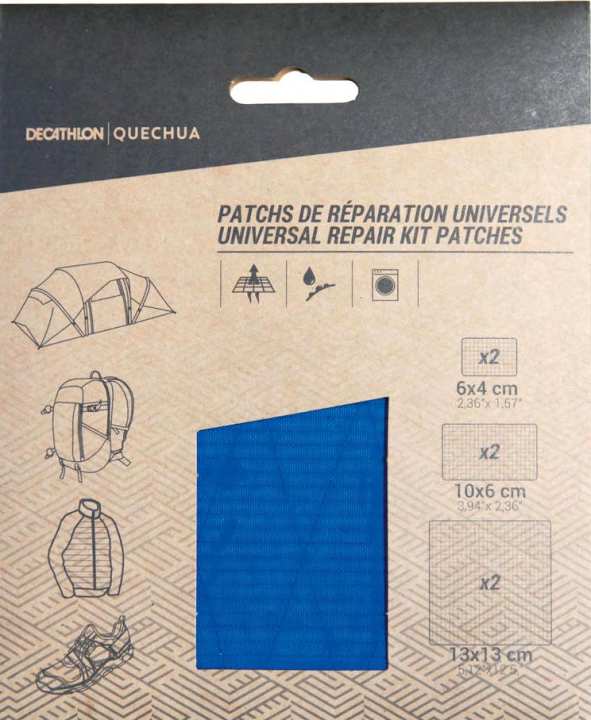
Special adhesive strips for quickly covering holes in clothing can be found in specialist outdoor shops, such as this set from Decathlon for 7 euros. Gore-Tex also offers a repair kit especially for breathable materials. Oiltank manufacturers and specialist retailers deliberately do not offer these kits as they advise against carrying out repairs yourself. There is a risk of increasing the damage caused by the adhesive
Repair of sailing clothing with canvas
If there is some canvas in the toolbox for repair purposes, the obvious idea is to make patches from it rather than cutting it out of your own oilskin. Unfortunately, our attempts with Dacron fabric were not crowned with success. The patches quickly peeled off again.
The DIY oilware repair:
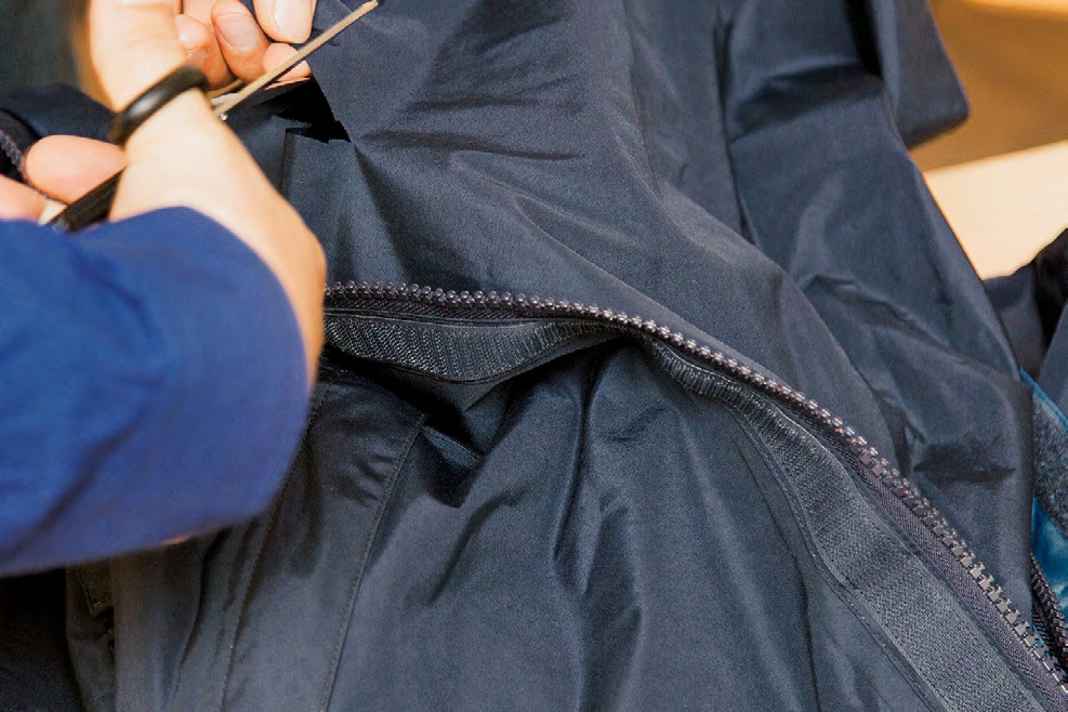





Repairing a zip
A patch cannot simply be glued onto a defective zip. It usually snags because a tooth is missing or displaced - the only long-term solution here is to have it replaced by the manufacturer. To continue using the jacket provisionally, the point where the zip is stuck must be shut down. This is where the zip usually opens unintentionally or gets caught. However, this solution does not cause any additional damage to the garment. However, if the zip is stuck on the jacket, this means that it can only be put on over the head until it has been repaired properly.
The materials to solve the problem are available on most boats: Needle, rigging twine and pliers. First close the damaged part of the zip, using the pliers to help carefully. Then the affected area is sewn together with a needle and thread. If the area on the front zip is further down, the zip shortened by a few centimetres will hardly be a problem.
This is how's made:




Correctly repairing and caring for oilskins: further tips
If an emergency repair is absolutely necessary, Raisa Mackarinus advises using adhesive tape from the first aid kit. This can be removed without leaving any residue and won't make the damage any worse. Another tip from the expert: really only wear your oilskins on board. In her experience, damage often occurs on land, for example when loading shopping into the car.
Last but not least, a repair is often not just a question of finances or sustainability, but also gives a second life to a cherished item of clothing in which many, many nautical miles have already been logged.
Outdoor Textile Repair- Good service for water sports enthusiasts
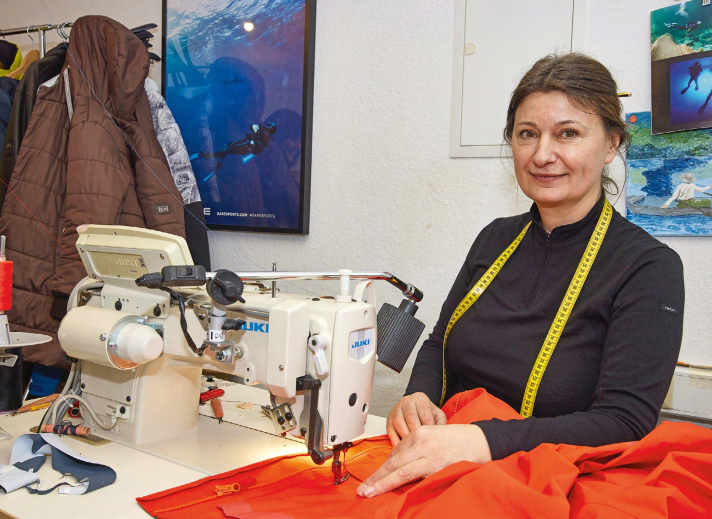
Raisa Mackarinus is a tailor with over 20 years of professional experience. She learnt how to work with multi-layered breathable materials at Helly Hansen. In her Outdoor Textile Repair workshop at Hamburger Chaussee 55 in Kiel, she and her team have already worked on Boris Herrmann's oilskins, but they also repair the suits of industrial divers and, of course, the functional clothing of many leisure skippers from all over Germany.

